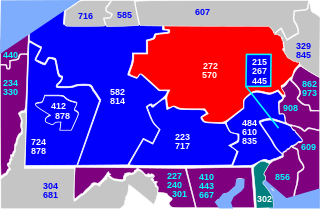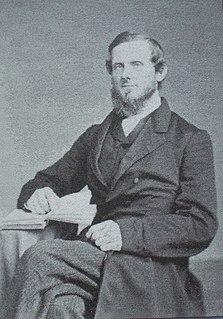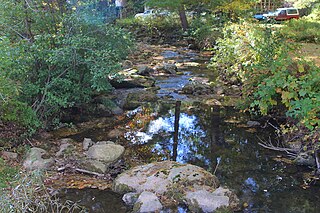Related Research Articles

Luzerne County is a county in the Commonwealth of Pennsylvania. The county has a total area of 906 square miles (2,350 km2) of which 890 square miles (2,300 km2) is land and 16 square miles (41 km2) is water, according to the U.S. Census Bureau. It is Northeastern Pennsylvania's second-largest county by total area and Northeast Pennsylvania's most populous county, with a population of 325,594 as of the 2020 census.

Mainville is a census-designated place in Columbia County, Pennsylvania, United States. The population was 132 at the 2010 census. It is part of the Bloomsburg–Berwick Micropolitan Statistical Area.

Area codes 570 and 272 are telephone area codes serving the northeast quadrant of Pennsylvania, including the cities/towns of Scranton, Wilkes-Barre, Williamsport, Stroudsburg, East Stroudsburg, Pittston, Carbondale, Hazleton, Clarks Summit, Towanda, Bloomsburg, Sayre, Tunkhannock, Berwick, Milford, Montrose, Honesdale, Pocono Pines, Nanticoke, Tamaqua, Shavertown, Dallas, Mahanoy City, Sunbury, Jim Thorpe, as far south as Pottsville and as far west as Lock Haven. 570 is the main area code, while 272 is an overlay covering the same territory as 570.

Catawissa Creek is a 41.8-mile-long (67.3 km) tributary of the Susquehanna River in east-central Pennsylvania in the United States. Its watershed has an area of 153 square miles (400 km2).
Service Electric is a group of affiliated cable television companies serving eastern Pennsylvania and western New Jersey. Service Electric also offers broadband Internet and telephone services through two partner companies, PenTeleData and Alianza.

The Sunbury Line is a rail line owned and operated by Norfolk Southern Railway which in turn is owned by the Norfolk Southern Corporation. The line travels from Sunbury, Pennsylvania, to Binghamton, New York, connecting with Norfolk Southern's Southern Tier Line at Binghamton and Norfolk Southern's Buffalo Line at Sunbury.

The Schuylkill Branch was a rail line owned and operated by the former Pennsylvania Railroad (PRR) in the U.S. state of Pennsylvania. The line ran from the Philadelphia to Harrisburg Main Line at 52nd Street in Philadelphia north via Norristown, Reading, and Pottsville to Delano Junction. From Delano Junction, the PRR had trackage rights over the Lehigh Valley Railroad's Hazleton Branch and Tomhicken Branch to Tomhicken, where the PRR's Catawissa Branch began. In conjunction with the Catawissa Branch, Nescopeck Branch, and Wilkes-Barre Branch, the Schuylkill Branch gave the PRR a direct line from Philadelphia to Wilkes-Barre.

The North Branch Division of the Pennsylvania Canal was a historic waterway that ran 169 miles (272 km) along the North Branch Susquehanna River between southern New York and north-central Pennsylvania in the United States. At its southern end, the canal connected with the West Branch Canal and the Susquehanna Division Canal at Northumberland, while on the north it connected with the Junction Canal and the New York canal system. Built between 1828 and 1856, the North Branch Canal was part of a large transportation network that included Pennsylvania's Main Line of Public Works.

The Lackawanna and Bloomsburg Railroad (LBR) was an 80-mile (129 km) long 19th century railroad that ran between Scranton and Northumberland in Pennsylvania in the United States. Incorporated in 1852, the railroad began operation in 1856 and was taken over by the Delaware, Lackawanna and Western Railroad in 1873. The western end of the line, from Northumberland to Beach Haven, is still in operation as the shortline North Shore Railroad.
Tomhicken is an unincorporated community in Sugarloaf Township, Luzerne County, Pennsylvania, United States. Tomhicken is notable for being a junction point between the Lehigh Valley Railroad's Tomhicken Branch and the Pennsylvania Railroad's Catawissa Branch. Tomhicken is part of the Greater Hazleton region.

The Catawissa Railroad was a railroad that operated in Pennsylvania between 1860 and 1953. For most of its lifespan it was leased by the Reading Company, and was subsequently merged into the Reading.

The Wilkes-Barre and Hazleton Railway was an electric railway in Luzerne County, Pennsylvania connecting the cities of Wilkes-Barre and Hazleton. It operated from 1903 to 1933 using a third rail and had no grade crossings. It was approximately thirty miles long and had one tunnel between Warrior Run and Nuangola through Penobscot Knob which Interstate 81 now crosses.
The Susquehanna, Bloomsburg, and Berwick Railroad, also known as the SB&B Railroad or the Weak and Weary Railroad, which referred to the fact that it was not a financial success, was a railroad in northeastern Pennsylvania until 1918. The route ran from Watsontown, Pennsylvania to Berwick, Pennsylvania. The railroad was 39.22 miles long, with 3.51 miles of branches, totaling 42.83 miles. The railroad was also known as the "Sweet By and By". Trains typically ran along the railroad six days a week. What remains of it is currently a subsidiary of the Pennsylvania Railroad Company.

David Jewett Waller Sr. was an American Presbyterian minister, entrepreneur, landowner and civic leader who lived in the American state of Pennsylvania. He also helped build several local railroads, such as the North and West Branch Railway and also owned many coal mines. By the time of his death, he was one of the most well-known people in northeastern Pennsylvania. He helped increasing the population and industrialization of Bloomsburg, Pennsylvania. He also organized and created a number of churches in Pennsylvania.

The Mountain Grove Campground was a campground, active between 1872 and 1901, that formed part of the 19th- to early 20th-century camp meeting movement, where camping was combined with worshiping and listening to preachers. These meetings were often held by Protestants, in this case, Methodists. Mountain Grove Campground was a site and resort on the Danville, Hazleton and Wilkes-Barre Railroad in Black Creek Township, Luzerne County, Pennsylvania, in the United States. It existed for approximately 30 years and was run by the Mountain Grove Camp Meeting Association. A businessman named G.M. Shoop was the original owner of the campground's land. Many prominent citizens of the surrounding area were in the association. During the campground's operation between 1872 and 1901, it was renovated and expanded several times. While the camp meetings that were held there were intended for Methodists, non-Methodists occasionally attended them.

Mountain Top yard or Penobscot yard is a rail yard in Mountain Top, Pennsylvania. It was built by the Lehigh Coal & Navigation Company (LC&N) in response to an 1837 bill authorizing a right of way and was established by 1840, at least as a construction camp for the Ashley Planes, in support of the construction of the Lehigh and Susquehanna Railroad trackage and operations to join the northern Anthracite Coal Region from barge loading docks along the Susquehanna in Pittston, in the Wyoming Valley, with the Lehigh Canal.
The Wyoming Division Canal was an anthracite canal in Luzerne County, Pennsylvania, in the United States. It was a branch of the North Branch Canal, which was one of only two major canals in Pennsylvania to be owned by the state. The creek went from West Nanticoke to Pittston, going through Luzerne County.

Scotch Run is one of the main tributaries of Catawissa Creek in Columbia County, Pennsylvania, in the United States. It is approximately 7.8 miles (12.6 km) long and flows through Beaver Township and Main Township. The stream's watershed has an area of 9.10 square miles (23.6 km2). The stream is infertile and acidic. It is 7.2 feet (2.2 m) wide in its upper reaches and 17.0 feet (5.2 m) wide in its lower reaches. The main rock formations in the watershed include the Mauch Chunk Formation, the Pocono Formation, the Pottsville Formation, and the Spechty Kopf Formation. The main soils include Leck Kill soil and Hazleton soil. It flows between Nescopeck Mountain and McCauley Mountain.
Sugarloaf Creek is a tributary of Tomhicken Creek in Luzerne County and Schuylkill County, in Pennsylvania, in the United States. It is approximately 3.5 miles (5.6 km) long and flows through Hazle Township and Black Creek Township in Luzerne County and North Union Township in Schuylkill County. The watershed of the stream has an area of 3.34 square miles (8.7 km2). The stream is considered to be a Coldwater Fishery. The main rock formation in the stream's watershed are the Mauch Chunk Formation and the main soil is the Hazleton soil. The creek has been impaired by acid mine drainage from the Oneida Number One Tunnel.
References
- 1 2 http://www.rootsweb.ancestry.com/~pamontou/spcase.htm [ user-generated source ]
- 1 2 3 4 5 6 7 8 Pennsylvania. Dept. of Internal Affairs (1888), Annual Report of the Secretary of Internal Affairs of the Commonwealth of Pennsylvania
- ↑ Mary Ann Lubinsky (2010), One Hundred Years of The Lehigh Valley
- 1 2 3 William Bender Wilson (1895), History of the Pennsylvania Railroad Company
- ↑ "Search results for: Record_ID:SILNMAHTL_13025M, page 1 | Collections Search Center, Smithsonian Institution".
- ↑ John H. White (1979), A History of the American Locomotive: Its Development, 1830-1880, ISBN 9780486238180
- ↑ Danville Historic District
- 1 2 Coleman, Lyman (1873). Guide-book of the Lehigh Valley Railroad and Its Several Branches and Connections. Philadelphia: J.B. Lippincott & Co.
- 1 2 One Hundred Years of The Lehigh Valley, 1946
- 1 2 Ted Fenstermacher (October 18, 1981), They Retreated to Mountain Park
- ↑ Columbia County Historical and Genealogical Society (2009), Early Columbia County, Pennsylvania, ISBN 9780738572017